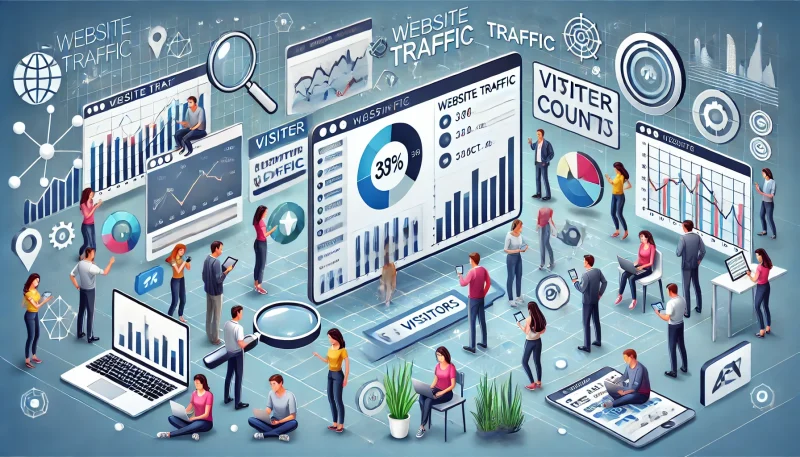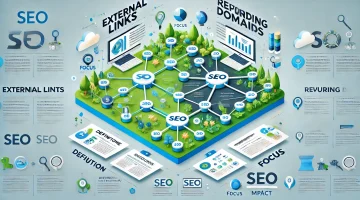
How to Measure Website Traffic: An In-Depth Guide
I. Introduction to Website Traffic
Website traffic refers to the number of users visiting and interacting with a website over a certain period. It’s a fundamental indicator of a website’s visibility and success. By tracking website traffic, site owners can glean insights into user behavior, optimize content, and strategize marketing efforts for greater engagement.
II. Types of Website Traffic
Direct Traffic
Direct traffic consists of visitors who navigate to a site by typing the URL directly into their browser or using a bookmark. This type of traffic often indicates brand loyalty and familiarity, as users intentionally seek out the website.
Organic Traffic
Organic traffic comes from search engines such as Google or Bing. Users reach the site by clicking on unpaid search results. High levels of organic traffic signal strong SEO practices and valuable content that aligns with user search intent.
Referral Traffic
Referral traffic refers to visitors who arrive from external websites through hyperlinks. This type of traffic is crucial for building domain authority and can be bolstered by strategic link-building efforts.
Social Traffic
Social traffic originates from social media platforms like Facebook, Twitter, Instagram, and LinkedIn. This type of traffic reflects the effectiveness of social media campaigns and content sharing.
Paid Traffic
Paid traffic is generated through advertising campaigns, such as pay-per-click (PPC) ads and display ads. Although it requires a financial investment, it can quickly boost website visibility and attract targeted audiences.
Email Traffic
Email traffic comes from users who visit a site by clicking on links within email campaigns. This type of traffic emphasizes the importance of email marketing strategies and personalized outreach to drive visitors.
III. Metrics for Measuring Website Traffic
Unique Visitors vs. Return Visitors
Unique visitors represent the number of distinct individuals visiting a site over a given period, while return visitors are those who come back after their initial visit. High numbers of return visitors often signify engaging content and a loyal audience.
Page Views
Page views count the total number of pages viewed by all visitors. This metric helps assess the overall interest in a website’s content.
Average Time on Page
This metric measures how long users typically stay on a page. Longer durations often indicate that the content is valuable and engaging.
Bounce Rate
Bounce rate represents the percentage of visitors who leave the site after viewing only one page. A high bounce rate may suggest that a page isn’t meeting user expectations or needs improvement in user experience.
Session Duration
The average session duration shows how much time visitors spend on the site during a single visit. It provides insight into the overall engagement level.
Conversion Rate
The conversion rate measures the percentage of visitors who complete a desired action, such as signing up for a newsletter or making a purchase. It’s a crucial metric for understanding the effectiveness of traffic in achieving business goals.
IV. Tools for Analyzing Website Traffic
Google Analytics
Google Analytics is a comprehensive tool that provides detailed insights into traffic sources, user behavior, and conversion metrics. It’s essential for tracking and optimizing website performance.
SEMrush and Ahrefs
Both SEMrush and Ahrefs offer advanced traffic analysis features, including competitor insights and keyword performance tracking.
Heatmap Tools (e.g., Hotjar)
Heatmap tools visually represent user interactions on a webpage, such as clicks and scrolling behavior. These tools help identify which sections of a page are most engaging.
Web Server Logs
Web server logs provide raw data on traffic, including IP addresses, timestamps, and requests made to the server. Analyzing these logs can offer additional insights into traffic trends and technical issues.
V. Factors That Influence Website Traffic
Search Engine Optimization (SEO)
SEO encompasses techniques that improve a website’s visibility on search engines. This includes on-page SEO (e.g., keyword usage, meta tags) and off-page SEO (e.g., backlinks).
Content Quality and Relevance
High-quality, relevant content is key to attracting and retaining visitors. Content that addresses user queries effectively encourages return visits and shares.
Website Speed and Performance
Slow-loading pages can frustrate users and lead to high bounce rates. Ensuring that a site is optimized for speed improves the user experience and boosts traffic.
Mobile-Friendliness
With the rise of mobile browsing, ensuring a website is responsive and functions well on all devices is essential for maintaining traffic.
User Experience (UX) and Design
A user-friendly design that enables easy navigation enhances engagement and encourages longer visits.
External Marketing Efforts
Social media campaigns, influencer partnerships, and email marketing all contribute to driving traffic to a website.
VI. Strategies for Increasing Website Traffic
SEO Best Practices
Optimize on-page elements like headings, meta descriptions, and content for relevant keywords. Off-page strategies like link building can further boost organic traffic.
Content Marketing
Regularly publishing informative and valuable content attracts visitors. Guest posting on reputable sites can also drive referral traffic.
Social Media Marketing
Leverage social platforms to share content and engage with audiences. Utilize hashtags, visual content, and interactive posts to drive traffic.
Paid Advertising
Invest in PPC campaigns to reach a targeted audience quickly. Tailor ads to align with user intent for better results.
Email Newsletters and Campaigns
Build a robust email list and send newsletters with engaging content and exclusive offers to encourage site visits.
Collaborative and Referral Strategies
Partner with other brands or influencers to gain exposure and drive referral traffic.
VII. Common Challenges in Driving Website Traffic
High Bounce Rates
High bounce rates can indicate that users are not finding what they’re looking for. Improving content relevance and user experience can mitigate this.
Decreasing Organic Reach
Algorithm changes can impact organic traffic. Staying updated on SEO trends helps maintain visibility.
Low Engagement
Analyzing user behavior and feedback can help identify why engagement is low and inform content adjustments.
Algorithm Changes
Search engine algorithm updates can significantly affect traffic. Adapting SEO strategies promptly is key to sustaining traffic levels.
VIII. Best Practices for Sustained Traffic Growth
- Update content regularly to keep it relevant.
- Incorporate interactive elements like polls and quizzes to engage users.
- Diversify traffic sources to reduce dependency on a single channel.
- Monitor performance and make data-driven optimizations.
IX. Conclusion
Understanding and optimizing website traffic is crucial for the success of any online presence. By measuring key metrics, leveraging the right tools, and implementing proven strategies, website owners can drive meaningful, sustained growth and achieve long-term business goals.



